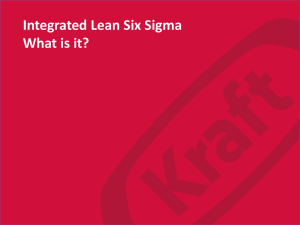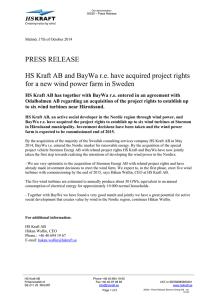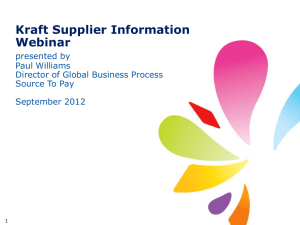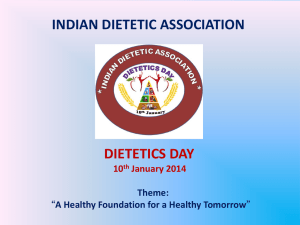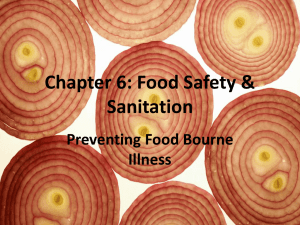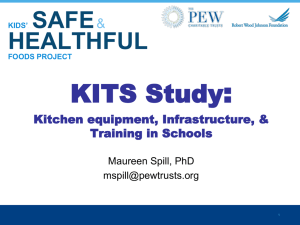Kent State Kraft KM Presentation
advertisement
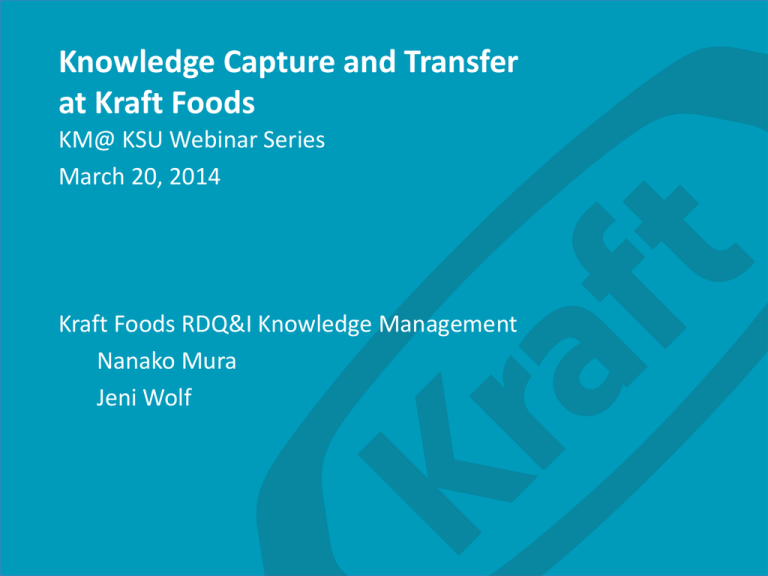
Knowledge Capture and Transfer at Kraft Foods KM@ KSU Webinar Series March 20, 2014 Kraft Foods RDQ&I Knowledge Management Nanako Mura Jeni Wolf Kraft Foods Group, Inc. AGENDA • Context – About Kraft Foods and KM – Our KM strategy and approach • Defining and Capturing Critical Knowledge – Assessing and prioritizing areas for Knowledge Capture – MASK method for capturing and modeling tacit knowledge – Knowledge Mapping for role transitions • Final Thoughts 2 Kraft Foods Group, Inc. Kraft at a Glance • • • • • Our products are found In 98% of U.S. households, 99% in Canada 10 brands with more than $500MM in 2012 annual sales Another 19 brands over $100MM $18+ billion net revenue More than 23,000 employees Source: Kraft Foods Group, Nielsen 3 Kraft Foods Group, Inc. Over 300 Years of Iconic Brands… and Counting 1897 1906 1880 1979 1957 1930 1988 1777 1862 1700 1903 1889 1927 1800 1900 1905 1780 1892 1870 1896 1883 Source: Kraft Foods Archives Kraft Foods Group, Inc. 1899 2000 1959 1928 1982 2011 1972 1933 1983 1954 4 2004 1965 1937 1966 1975 Kraft has over 750 R&D employees located across US and Canada Toronto Madison Glenview Montreal Tarrytown East Hanover Memphis RDQ&I Centers Satellite locations 5 Kraft Foods Group, Inc. Research, Development, Quality and Innovation Organization Chuck Davis EVP RDQ&I Business Units Canada Center Support Quality and Food Safety Research & Supplier Integration Packaging Research and Innovation Strategy Foodservice Beverage Cheese & Dairy Assoc. Director- IP, KM, Training Nanako Mura Oscar Mayer Enhancers and Snack Nuts Meals and Desserts 6 Kraft Foods Group, Inc. Assoc. Prin. Scientist - KM Jeni Wolf KM, IP Analyst Kathy Sullivan Assoc. Prin. Scientist Training Open Assoc. Prin. Scientist – IP Rathna Koka Role of the Knowledge Management Team Provides foundational • Internal knowledge capture, transfer & reuse capabilities for RDQ&I to • Access to external knowledge and information create winning products • Training Academy • Knowledge capture tools Source of best practices • Documentation tools and tools • Collaboration tools Capture and lever economies of scale • Management of subscription databases, licenses, print resources, doc delivery Subject matter expertise • Technical landscape search that BU’s cannot fully • Management of physical libraries • Administration of tools establish on own 7 Kraft Foods Group, Inc. Impetus for creating a Knowledge Management strategy Kraft Foods Group, Inc. Situations resulting in knowledge at risk Retirements Internal moves Attrition R&D center relocation Geographic dispersion Re-structuring and decentralization Spin-off/divestiture 9 Kraft Foods Group, Inc. Over the last 3-4 years, the KM strategy has focused on helping R&D “Know What We Know” Expertise Management Connect to and lever experts Collaboration & Social Networks Lever the collective power of the organization Documentation & Content Management 10 Capture, organize, transfer & archive information Tacit Knowledge Capture Capture experiential knowledge, know how Underlying everything are tools/processes and change management Kraft Foods Group, Inc. Knowledge management plays an important role in supporting Kraft’s mission and key strategies Make Kraft THE North American Food & Beverage Company 11 Kraft Foods Group, Inc. Assessing Tacit Knowledge Needs Identify Knowledge Fields of Interest 12 Collect Information on Criticality Analyze of Each Field Prioritize Critical Fields for Capture • Based on MASKII a technique developed by the French Atomic Energy Commission by staff at the Universite de Technologie de Troyes • Structured approach • Identify most critical fields at risk • Match those fields with an appropriate KRT method Kraft Foods Group, Inc. Identify Fields of Knowledge for Retention • Solicit a list from RDQ&I Leadership • Representation from each Business Unit • Focus on areas most important to the Business – Employees likely to retire in the next 1-3 years – Technical areas with uni-personal knowledge – Technologies that are critical but not formally documented KM Group Role: Prioritize needs against resource availability and available techniques 13 Kraft Foods Group, Inc. Identify Critical Knowledge • Rare – Number and availability of knowledge holders – Availability of knowledge outside Kraft – Are we a leader in this field • Useful – Alignment with mission and goals – Emergence of the field – Adaptability of the field • Difficult to acquire – Difficulty of identifying sources for the knowledge – Role of networks • Difficult to apply – Depth of the knowledge – History of the field – Role of external factors 14 Kraft Foods Group, Inc. Evaluate both present and predicted future criticality Interview Process • 2 technical experts + 1 manager per knowledge field • Scored the knowledge field against the 11 questions – Questions were not shared prior to the interview – Interviews were less than 30 minutes each • Gathered commentary – Gives meaning and depth to the score – Used to help scope out knowledge capture – Gathered names of additional people with expertise 15 Kraft Foods Group, Inc. Rarity of the Knowledge Criteria Number and Availability of Kraft Knowledge Holders Availability of Knowledge Outside of Kraft Difficulty of Using the Knowledge Difficulty of Acquiring the Knowledge Strategic Breadth of the Knowledge Leadership Alignment with Kraft's Mission and Goals Emergence Adaptability Difficulty of identifying sources for the knowledge Level 1 Rare: Few people at Kraft share the expertise and they are not very available. Interest not expressed: The strategy does not mention this field. Expressed interest: The strategy mentions this field, but depends only slightly on it to achieve its objectives. Old or substitutable: Field under development: It is an old field of The field is emerging, but knowledge and can be the way in which it is replaced by a more current developing doesn't field correspond to Kraft's objectives. Strong expections: The field plays a larger role in achieving strategic objectives, but is not the largest factor. Current field: The field is emerging at a steady rate and developing in a way that links to Kraft's objectives. Non adaptable: Reuse is never considered, adaptation for another context is impossible. Slightly adaptable: Knowledge can be used in different contexts, but it is difficult to adapt. Adaptable: It is possible to use and adapt the knowledge to different contexts. Structured: Everyone has the means to id the person and/or information that they need in the field. Organized: Kraft has tools or networks in place for people to find what they need, but these resources are not always known to everyone. Personalized: Each individual has their own network, tools or method of finding the information that are not shared. Technical: We have the knowledge we need to solve problems, but not to really explain the problems. Specialist: We have the knowledge to solve problems and explain why the solution worked. Non expert: This field isn't one where anybody is considered an expert. Insignificant history: The field is recent, or its history isn't known. Dependence on the environment Kraft Foods Group, Inc. Priority: The field is identified as integral to achieving strategic objectives. Emergence The field is emerging quickly and in a way that is strongly linked with Kraft's objectives. We have an interest in pushing the emergence of the field. Easily adaptable The knowledge is reusable and easily adaptable to other contexts. Unorganized: It is difficult for all to find what they need. Everytime a need arises is an emergency. No or few networks, tools or standard methods. Accessible network: Complicated network: Complex network: It is simple and easy to It is simple and easy to It is difficult and time build a network in the field build a network in the field, consuming to build or of knowledge. Networks and a network is necessary connect with a network. are useful, but not to have command of the The people involved with absolutely necessary. field. the field are heterogeneous and aren't thought of as a single community. Existance of history: There are some notable events in the history of the field, and understanding just the notable events is enough to understand the field. No dependence: Internal dependence: The field is self contained. The development of the There is very little field relies on Kraft dependence on internal or regulations and external factors. environmental factors. Additional Commentary 16 Level 4 Unipersonal: There is a single expert are unavailable most of the time or is no longer with Kraft. Specific: Exclusiveness: Very few organizations Kraft is the only org that has practice the field - it is rare. competencies and knowhow in the field, it is impossible to get from the outside. Minor: Secondary: Major: Dominant: Kraft plays a very minor role Kraft plays in this field, but Kraft is one of the most Kraft has proven dominance in this field. is not known for our active organizations in this in the field and is contribution. field. recognized as a leader. Role of networks History of the knowledge Level 3 Shared: Many people with the company share expertise and they are readily available. Externalizable: Common: Other orgs practice the field Other orgs practice the and can carry out work. Can field, but it cannot be easily be easily externalized. externalized. No need of network: Having command of the field does not require a network. Depth of the knowledge Level 2 Universal: Everyone in the Kraft unit controls the knowledge of the field. Marked history: Understanding the history of the field is helpful in mastering the area. Controllable dependence: The development of the field relies on environmental factors, but it has some influence over those factors. (Contracts, org. objectives) Expert: We have the knowledge to solve complex problems with complex solutions that are understood, identified and explained. Historical base: It is impossible to understand the field without knowing its history. History is an integral part of the field. Uncontrollable dependence: The development of the field is dependent on unavoidable external factors which it does not have influence over. (Regulations, budgets) Expert 1 Choice Expert 1 Commentary Expert 2 Choice Expert 2 Commentary Manager Choice Manager Commentary Analyze Each Field of Knowledge Criteria Planning Experts Difficulty of Using the Knowledge Difficulty of Acquiring the Knowledge Strategic Breadth of the Knowledge Rarity of the Knowledge Impacts Beverages Dairy Quality Snacks J. Baril D. Parker A. Thompson (juice) D. Reddy B. Dias C. Galer? P. Gass? D. Seman S. Quickert C. Austin? D. Smyth R. Sauer Y - Reddy None Y- Baril Extended to 12/2013 Y - Barron (conf. no Y - Andy extension) Thompson extended to 08/2013 Packaging Meals Coffee Shared Tech. T. Tedeschi A. del Castillo R. Villota G. Haro R. Apiscopa J. Zimmerman D. Hayes N. Rerngsamai D. Johnson M. Bordonaro None T. Tedeschi None Y - Apiscopa (no extension) and Hayes None Number and Availability of Kraft Knowledge Holders 6 5 7 6 4 6 7.5 6 5 Availability of Knowledge Outside of Kraft 6 4 3 4 4.5 6 6 6 4 Leadership** 3 4 2 4 4 3 3 3 3 TOTAL 15 13 12 14 12.5 15 16.5 15 12 Alignment with Kraft's Mission and Goals** 3 4 4 4 4 4 4 4 4 Emergence 5 6 7 8 5 6 3 4 2 Adaptability 4 5 6 5 5 8 2.5 3.5 6 TOTAL 12 15 17 17 14 18 9.5 11.5 12 Difficulty of identifying sources for the knowledge 6 4 6 6 6 4 7 6.5 5 Mobilization of networks 6 6 6 7.5 6 6 8 7 6 TOTAL 12 10 12 13.5 12 10 15 13.5 11 Depth of the knowledge 7 8 6.5 5.5 4 6 6.5 7 8 History of the knowledge 6 8 5 6 7 6 3 6 8 Dependence on the environment 6 6 5 6 6.5 6 3 6 4 TOTAL 19 22 16.5 17.5 17.5 18 12.5 19 20 58 52 60 52 57.5 51.5 62 54 56 48 61 54 53.5 46.5 59 52 55 48 OVERALL TOTAL TOAL MINUS MANAGER INPUT 17 Meat W. Barron S. Brackebusch C. Sawyer Kraft Foods Group, Inc. Prioritizing Each Field of Knowledge 18 Kraft Foods Group, Inc. Prioritized Fields for Capture • Scores sub totaled for each area of criticality • Scores totaled for each Field of Knowledge • Final recommendation based on 3 factors: – Scores – Commentary – Timeline of retiring experts 19 Kraft Foods Group, Inc. Knowledge Books and the MASK Method (Method for Analyzing and Structuring Knowledge) • First developed for the French Atomic Energy Commission • Later developed at academic institutions • Further developed through applications in large companies 20 Kraft Foods Group, Inc. Success Factors • The expert(s) must be available to participate and make the Knowledge Book a priority – – • The needs of future recipients of the Knowledge Book must be considered • Existing relevant documentation should be included in the Knowledge Book – – • • A champion identified to own it and socialize it Integrated into training on the topic The field covered by the Knowledge Book must be largely stabilized – • By reference or including the content Important not to under estimate time requirements of this step Knowledge Books should be living objects – – 80% well defined and stable; 20% exploratory and growing Human factors – 21 Management support is key Engage a Recipient early to support the expert Ability of experts to communicate knowledge in a structured format Kraft Foods Group, Inc. End Product • • 22 PowerPoint in editable form Table of Contents is the Entry Point into the Knowledge Book; click to navigate Kraft Foods Group, Inc. Knowledge Book Steps Scoping Interview Knowledge Conversation 1 (Immersion) 2H 4H … Knowledge Conversation N Integration of relevant documents Validation 4H TBD 2-6 Wks All interviews are recorded 23 Kraft Foods Group, Inc. Sharing Scoping the Knowledge Book • Define the breadth and depth of the field of knowledge • Identify areas for focus • Identify areas that are out of scope • Incorporate information gathered during the knowledge assessment • Validate and obtain feedback – Direct manager of Expert – Knowledge Book Champion – Knowledge Book Recipients • 24 Scope flexes during the process and is non-exhaustive Kraft Foods Group, Inc. MASK Elicitation Interviews • 1:1 meetings between the facilitator and the expert – 1 expert at a time to avoid cross talk between experts • Facilitator has no prior knowledge of the subject – Avoid assumptions and bias – Common question are why, how, what else, what is next • Scope document helps initiate conversation – Conversation is allowed to flow naturally • Modeling is done via notes on large pieces of paper – Computer is avoided – digital distraction • Audio of conversation is recorded – Used to help fill in the models – 4 hours of elicitation takes 8-16 hours to fully model 25 Kraft Foods Group, Inc. MASK Modeling Fundamentals A body of knowledge (Knowledge Corpus) can be reflected in 6 points of view: 26 Kraft Foods Group, Inc. Sample MASK Activity Model Making a Pie Crust • • • • • • Bowl Pastry Cutter Measuring Cups • • Ingredient knowledge Process knowledge Flour Butter Water • Refrigerator • Plastic wrap Prepare the pie dough ? Dough • Rolling pin • Pie plate Rest the dough Dough know-how Rested Dough • Oven Shape the crust • It is best to roll the dough on a smooth surface like a stone countertop • Use a small amount of flour to avoid sticking. Too much flour will toughen the dough Knowledge of baking phenomena Crust ready to bake Bake the crust Baked Crust 27 Kraft Foods Group, Inc. Sample MASK Phenomenon Model Baking a Pie Crust Influence • Type of flour • Type of fat Source Target Flour particles coated in fat Flaky pie crust Triggering Event: • Combining of ingredients • Cooking • Steam is released • Doug is slightly expanded. • Water is converted to steam during baking. • Size of coated flour particle impacts final texture • Over mixing of ingredients can limit steam 28 Kraft Foods Group, Inc. Consequence: • Thin and flaky crust Flow • Initial oven temperature impacts steam generation Sample Concept Model Pastry Pastry Pie Pastry Short Crust Bread Dough Flaky Crust • • 29 Cakes Yeast Dough Kraft Foods Group, Inc. Bread Bagels Sweet Dough • • Sweet rolls Donuts Muffins Sheet Cakes Sample Task Model Making Bread Making Bread // // Measure flour into a bowl Knead the dough Set ½ cup of flour aside Add yeast Make a well in the flour Add water Dust hands with reserved flour Form the loaf Cover the loaf and rise Specialty bread Add additional ingredients 30 Kraft Foods Group, Inc. Bake the loaf Plain bread Leave as is History Model Evolution of the Knowledge Domain Timeline A Ex. Product Development Generation 1 • • 31 Kraft Foods Group, Inc. Generation 3 OBJECTIVE Timeline B Ex. Package Development Timeline C Ex. Product Launch Generation 2 Milestone (date) Generation 1 Generation 2 OBJECTIVE OBJECTIVE Milestone (date) Generation 1 Generation 2 Lineage Model Evolution of Specific Concepts or Objects Evolution Drivers Pros and cons 1st Generation 2nd Generation Start Date – End Date Start Date – End Date Pros and cons 3rd Generation Start Date – End Date Evolution Drivers Pros and cons 32 Kraft Foods Group, Inc. Structure of a Knowledge Book • Table of Contents is the starting point • Divided into sections accessed by links from a Table of Contents • Many links within the models to additional explanation and related materials • Elicitation style and approach of the expert drives the end product – Books that have fewer models and more text explanation – Books that have more models and more pictures and charts 33 Kraft Foods Group, Inc. Example of a Highly Visual Book 34 Kraft Foods Group, Inc. Example of a Highly Textual Book 35 Kraft Foods Group, Inc. Advantages of Knowledge Modeling • A picture is worth a thousand words • Wide applicability – not case specific • Ability to reflect a complex knowledge area – Captures decision processes and ways of thinking – Several models taken together for a complete depiction – Extensive linking of models and content • Integrates and incorporates information sources – If a document exists incorporate rather than re-model – Link to external content, reference it or add it verbatim within the book – Ex. Technical Reports, photos, videos, books, journal articles 36 Kraft Foods Group, Inc. Socializing the Knowledge Book • Expert and/or Knowledge Book Recipient presents the book • Expert and/or Knowledge Book Recipient submits the book as a Tech Report in R&D Suite • Champion communicates the existence of the book • Recipient updates the book • Used as an element of formal training classes offered through Kraft University 37 Kraft Foods Group, Inc. Process Cheese Knowledge Book – 18 Months Later • Systematically shared via presentation shortly after completion • Contents are generalized for training for non-technical internal audiences • Verbatim excerpts for technical training • Tool for new employee orientation • Used by senior experts as a standard reference “I found it extremely enlightening because it highlighted and put structure on what we learn. Often we create knowledge in seemingly random efforts, but this exercise help organize our areas of expertise and even highlight areas that could use more attention in the future” – Kraft expert 38 Kraft Foods Group, Inc. Additional Reading How to capitalize knowledge with the MASK method? Nada Matta; Jean-Louis Ermine; Gerard Aubertin; Jean-Yves Trivin http://aries.serge.free.fr/document/How%20to%20capitalize%20knowledge%20with%20the%20MAS K%20method.pdf The MASK Method: http://aries.serge.free.fr/document/The%20MASK%20Method%20.pdf English Documents from Jean-Louis Ermine http://aries.serge.free.fr/index.php?page=content/MASK/SA32#English 39 Kraft Foods Group, Inc. Knowledge Mapping 40 • For fast knowledge retention and transfer • Mind map of responsibilities and activities that make up a role • Shows connections and interdependencies within a role • Act as a training guide for managers who are new to their roles • Identify knowledge that is unique to an individual • Blueprint for future knowledge transfer Kraft Foods Group, Inc. Sample Knowledge Map (Concise View) 41 Kraft Foods Group, Inc. Final Thoughts • Keys to Success – Senior Management support and advocacy – Must be business driven – Make it engaging and rewarding for the experts • Involvement in Knowledge Retention and Transfer Activity is the ultimate professional complement 42 Kraft Foods Group, Inc.
